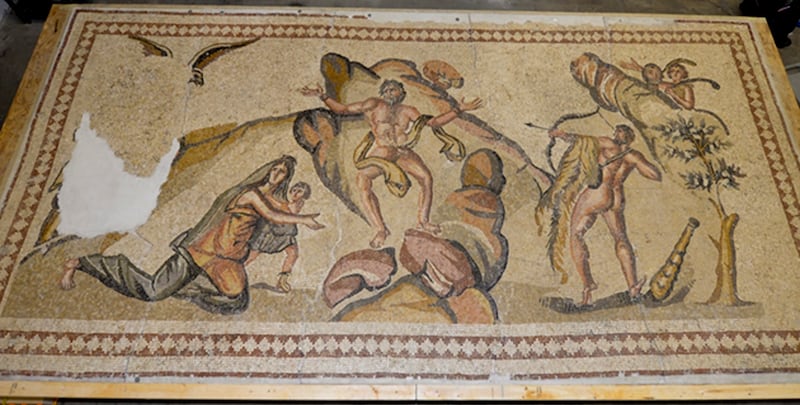Syria uncovered a large, intact mosaic that dates back to the Roman era, describing it on Wednesday as the most important archaeological discovery since the country’s conflict began 11 years ago.
Journalists were shown the mosaic in the central town of Rastan near Homs, Syria’s third-largest city.
The mosaic, at 120 square metres, was found in an old building that Syria’s General Directorate of Antiquities and Museums was excavating. Lebanese and Syrian businessmen from the neighbouring country’s Nabu Museum bought the property, which dates from the fourth century and donated it to the Syrian state. Each panel was filled with small, square, colourful stones measuring about half an inch on each side.
Humam Saad, associate director of excavation and archaeological research at the directorate, said among the scenes the mosaic shows is a rare portrayal of Ancient Amazon warriors in Roman mythology.
“What is in front of us is a discovery that is rare on a global scale,” Mr Saad told The Associated Press, describing the images as being “rich in details” and including scenes from the Trojan War between the Greeks and Trojans.
In Ancient Greek and Roman mythology, the demigod hero Hercules slayed Hippolyta, queen of the Amazons, in one of his 12 labours.
The mosaic also portrays Neptune, Ancient Roman god of the sea, and 40 of his mistresses.
“We can’t identify the type of the building, whether it’s a public bathhouse or something else, because we have not finished excavating yet,” Mr Saad told the AP.
Sulaf Fawakherji, a famous actress in Syria and a member of the Nabu Museum’s board of trustees, said she hopes they can buy other buildings in Rastan, which she says is filled with heritage sites and artefacts waiting to be discovered.
“There are other buildings, and it’s clear that the mosaic extends far wider,” Fawakherji told the AP. “Rastan historically is an important city, and it could possibly be a very important heritage city for tourism.”
Despite Rastan’s historical significance in the country, Mr Saad says there had not been significant excavation efforts in the town before the armed conflict in the country.
“Unfortunately, there were armed groups that tried to sell the mosaic at one point in 2017 and listed it on social media platforms,” he said.
Syrian heritage sites have been looted and destroyed over the past decade of violent conflict.
Among the most notable incidents was the ISIS terrorist group taking Palmyra, a Unesco World Heritage Site with 2,000-year-old towering Roman-era colonnades and priceless artefacts, and partially destroying a Roman theatre. Meanwhile, Syria’s cash-strapped government has slowly been rebuilding Aleppo’s centuries-old bazaar after reclaiming it from armed opposition forces in 2016.
Rastan was once a major opposition stronghold and a point of intense clashes, before the Syrian government reclaimed the city in 2018.






